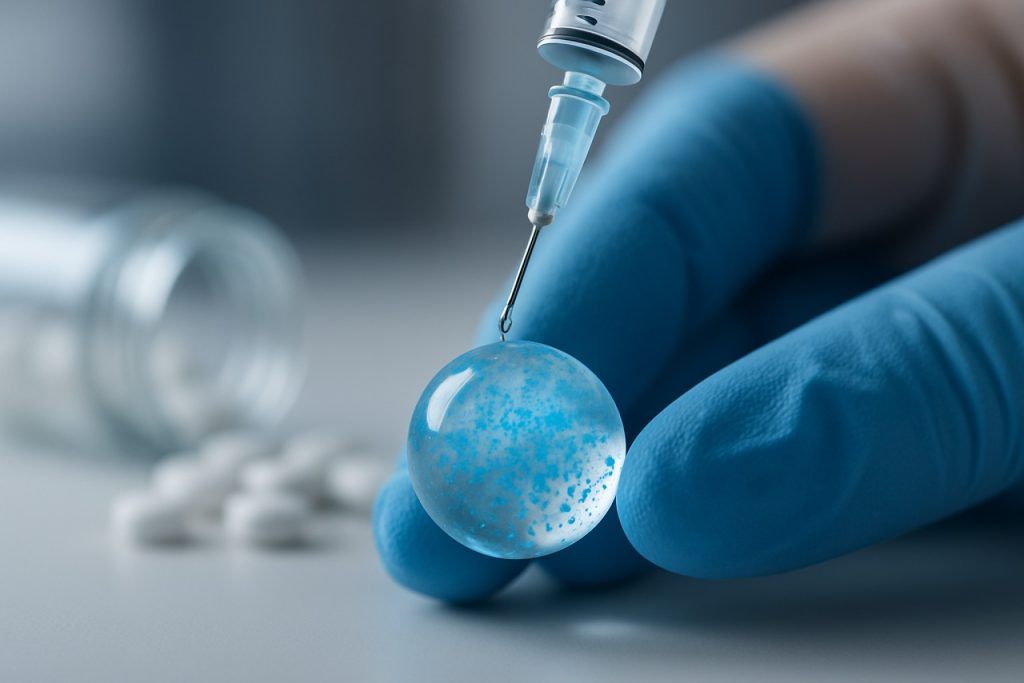
Osmotic Swellable Hydrogels in Drug Delivery Systems: The Science, Breakthroughs, and Future Impact of a Game-Changing Technology
- Introduction to Osmotic Swellable Hydrogels
- Mechanisms of Osmotic Swelling and Drug Release
- Advantages Over Traditional Drug Delivery Methods
- Recent Innovations and Research Highlights
- Challenges and Limitations in Clinical Applications
- Case Studies: Success Stories in Therapeutic Delivery
- Future Prospects and Emerging Trends
- Conclusion: The Road Ahead for Hydrogel-Based Drug Delivery
- Sources & References
Introduction to Osmotic Swellable Hydrogels
Osmotic swellable hydrogels are a class of hydrophilic polymer networks capable of absorbing significant amounts of water or biological fluids, leading to pronounced swelling without dissolving. This unique property is primarily driven by osmotic pressure differences between the hydrogel matrix and the surrounding environment. In drug delivery systems, these hydrogels have garnered considerable attention due to their ability to modulate drug release profiles, enhance bioavailability, and provide site-specific delivery. The swelling behavior, governed by the polymer composition, crosslinking density, and environmental stimuli (such as pH, ionic strength, and temperature), allows for precise control over the rate and duration of drug release, making them highly versatile for various therapeutic applications.
The integration of osmotic mechanisms into hydrogel design enables the development of advanced drug delivery platforms that respond dynamically to physiological conditions. For instance, in oral drug delivery, osmotic swellable hydrogels can protect sensitive drugs from the harsh gastric environment and facilitate their release in the intestine, where absorption is optimal. Additionally, these hydrogels can be engineered to respond to specific triggers, such as glucose levels or inflammatory markers, enabling on-demand drug release for chronic conditions like diabetes or inflammatory diseases. The biocompatibility, tunable mechanical properties, and minimal toxicity of these materials further support their clinical potential. Recent advances in polymer chemistry and fabrication techniques continue to expand the capabilities and applications of osmotic swellable hydrogels in modern drug delivery systems National Institutes of Health, U.S. Food & Drug Administration.
Mechanisms of Osmotic Swelling and Drug Release
Osmotic swellable hydrogels function as advanced drug delivery systems by leveraging their unique ability to absorb water and expand in response to osmotic gradients. The swelling process is primarily governed by the difference in osmotic pressure between the hydrogel’s polymer network and the surrounding biological environment. When placed in an aqueous medium, hydrophilic groups within the hydrogel matrix attract water molecules, causing the network to expand. This swelling is counterbalanced by the elastic retraction forces of the polymer chains, resulting in a dynamic equilibrium that determines the final swollen state of the hydrogel National Institutes of Health.
The drug release from osmotic swellable hydrogels is intricately linked to their swelling behavior. As the hydrogel swells, the mesh size of the polymer network increases, facilitating the diffusion of encapsulated drug molecules. The rate and extent of drug release can be modulated by adjusting the crosslinking density, polymer composition, and the presence of ionic or pH-responsive groups within the hydrogel. In some designs, the osmotic pressure can be further manipulated by incorporating osmogens—substances that enhance water influx—thereby accelerating swelling and drug release in a controlled manner Elsevier.
This mechanism allows for sustained and predictable drug delivery, minimizing burst release and enabling site-specific targeting. The interplay between osmotic swelling and drug diffusion is critical for optimizing therapeutic efficacy and reducing side effects, making osmotic swellable hydrogels a promising platform for next-generation drug delivery systems Royal Society of Chemistry.
Advantages Over Traditional Drug Delivery Methods
Osmotic swellable hydrogels offer several distinct advantages over traditional drug delivery methods, making them highly attractive for advanced pharmaceutical applications. One of the primary benefits is their ability to provide controlled and sustained drug release. By leveraging osmotic pressure and the hydrogel’s swelling properties, these systems can maintain a consistent drug release rate, minimizing the peaks and troughs associated with conventional dosage forms and reducing the risk of side effects or sub-therapeutic dosing U.S. Food & Drug Administration.
Another significant advantage is the hydrogels’ responsiveness to physiological conditions. Osmotic swellable hydrogels can be engineered to respond to specific stimuli such as pH, temperature, or ionic strength, enabling site-specific drug delivery and further enhancing therapeutic efficacy National Institute of Biomedical Imaging and Bioengineering. This targeted approach reduces systemic exposure and potential toxicity, which is particularly beneficial for potent drugs or those with narrow therapeutic windows.
Additionally, these hydrogels are typically biocompatible and can be designed to degrade safely within the body, minimizing the risk of chronic inflammation or foreign body reactions. Their high water content also mimics natural tissue environments, improving patient comfort and compliance National Center for Biotechnology Information. Collectively, these advantages position osmotic swellable hydrogels as a superior alternative to traditional drug delivery systems, offering improved safety, efficacy, and patient-centric outcomes.
Recent Innovations and Research Highlights
Recent years have witnessed significant advancements in the design and application of osmotic swellable hydrogels for drug delivery systems. Innovations have focused on enhancing the responsiveness, biocompatibility, and drug release profiles of these hydrogels. One notable development is the integration of stimuli-responsive polymers, which enable hydrogels to modulate their swelling behavior in response to physiological triggers such as pH, temperature, or ionic strength. This allows for more precise, site-specific drug release, minimizing systemic side effects and improving therapeutic efficacy National Center for Biotechnology Information.
Another research highlight is the incorporation of nanomaterials, such as graphene oxide or silica nanoparticles, into hydrogel matrices. These nanocomposites exhibit improved mechanical strength and controlled swelling kinetics, which are crucial for maintaining structural integrity during drug delivery and achieving sustained release profiles Elsevier. Additionally, advances in 3D printing technology have enabled the fabrication of hydrogels with complex architectures and tunable porosity, further optimizing drug loading and release characteristics Nature.
Recent studies have also explored the use of biodegradable and naturally derived polymers, such as chitosan and alginate, to enhance the safety and environmental compatibility of osmotic swellable hydrogels. These materials not only reduce the risk of long-term toxicity but also support the development of eco-friendly drug delivery platforms MDPI. Collectively, these innovations are paving the way for next-generation drug delivery systems with improved patient outcomes and broader clinical applications.
Challenges and Limitations in Clinical Applications
Despite their promising potential, osmotic swellable hydrogels face several challenges and limitations that hinder their widespread clinical application in drug delivery systems. One major concern is the precise control of swelling behavior in physiological environments. Variations in pH, ionic strength, and temperature within the human body can unpredictably alter the hydrogel’s swelling kinetics, potentially leading to inconsistent drug release profiles and suboptimal therapeutic outcomes (U.S. Food and Drug Administration). Additionally, the biocompatibility and long-term safety of certain synthetic polymers used in hydrogel fabrication remain under scrutiny, as degradation products may elicit inflammatory or immunogenic responses (National Institutes of Health).
Another significant limitation is the mechanical strength of hydrogels. Many osmotic swellable hydrogels are inherently soft and fragile, which can compromise their structural integrity during implantation or under physiological stresses, especially in load-bearing tissues (European Medicines Agency). Furthermore, the scalability and reproducibility of hydrogel synthesis present manufacturing challenges, as slight variations in polymer composition or crosslinking density can lead to batch-to-batch inconsistencies.
Regulatory hurdles also pose a barrier, as comprehensive preclinical and clinical evaluations are required to ensure safety, efficacy, and quality control. The complexity of hydrogel-drug interactions and the need for tailored release profiles for different therapeutic agents further complicate the translation from laboratory research to clinical practice (World Health Organization). Addressing these challenges is essential for the successful integration of osmotic swellable hydrogels into advanced drug delivery systems.
Case Studies: Success Stories in Therapeutic Delivery
Osmotic swellable hydrogels have demonstrated significant promise in therapeutic drug delivery, as evidenced by several notable case studies. One prominent example is the use of poly(ethylene glycol)-based hydrogels for the controlled release of insulin in diabetic patients. These hydrogels, engineered to respond to glucose concentrations, swell osmotically and modulate insulin release accordingly, resulting in improved glycemic control and reduced risk of hypoglycemia. Clinical trials have shown that such systems can maintain therapeutic drug levels over extended periods, enhancing patient compliance and outcomes (National Institutes of Health).
Another success story involves the application of chitosan-based osmotic hydrogels for localized cancer therapy. In this approach, chemotherapeutic agents are encapsulated within the hydrogel matrix, which swells in response to the tumor microenvironment, enabling site-specific and sustained drug release. Preclinical studies have reported significant tumor regression and minimized systemic toxicity, highlighting the potential of these hydrogels in improving the therapeutic index of anticancer drugs (National Cancer Institute).
Additionally, osmotic swellable hydrogels have been utilized in the delivery of antibiotics for chronic wound management. By providing a moist environment and releasing antibiotics in a controlled manner, these hydrogels accelerate wound healing and reduce infection rates. Clinical evaluations have confirmed their efficacy in treating diabetic foot ulcers and other chronic wounds (U.S. Food and Drug Administration).
These case studies collectively underscore the versatility and clinical potential of osmotic swellable hydrogels in advancing therapeutic delivery across diverse medical fields.
Future Prospects and Emerging Trends
The future of osmotic swellable hydrogels in drug delivery systems is marked by rapid innovation and interdisciplinary research, aiming to overcome current limitations and expand therapeutic applications. One emerging trend is the integration of smart, stimuli-responsive functionalities, enabling hydrogels to release drugs in response to specific physiological triggers such as pH, temperature, or glucose levels. This approach enhances precision in drug delivery, particularly for chronic diseases like diabetes and cancer, where controlled and on-demand release is crucial Nature Reviews Materials.
Advancements in hydrogel composition, such as the incorporation of nanomaterials and bioactive agents, are also being explored to improve mechanical strength, biocompatibility, and targeted delivery. The use of biodegradable and naturally derived polymers is gaining traction, addressing concerns about long-term biocompatibility and environmental impact Elsevier – Advanced Drug Delivery Reviews. Furthermore, 3D printing and microfabrication technologies are enabling the design of hydrogels with complex architectures and tunable properties, paving the way for personalized medicine and patient-specific drug delivery systems U.S. Food and Drug Administration.
Looking ahead, the convergence of hydrogel technology with digital health tools, such as wearable sensors and wireless monitoring, could facilitate real-time feedback and adaptive drug release. Regulatory pathways and scalable manufacturing remain challenges, but ongoing research and collaboration between academia, industry, and regulatory bodies are expected to accelerate clinical translation and commercialization of next-generation osmotic swellable hydrogel-based drug delivery systems.
Conclusion: The Road Ahead for Hydrogel-Based Drug Delivery
The future of osmotic swellable hydrogels in drug delivery systems is marked by both promise and challenge. These hydrogels, with their unique ability to absorb water and swell in response to osmotic gradients, have demonstrated significant potential for controlled and sustained drug release, particularly for oral, transdermal, and implantable applications. Their tunable swelling behavior allows for precise modulation of drug release kinetics, which is crucial for achieving therapeutic efficacy and minimizing side effects. Recent advances in polymer chemistry and hydrogel engineering have enabled the development of smart hydrogels that respond to physiological stimuli such as pH, temperature, and specific biomolecules, further enhancing their versatility in personalized medicine National Center for Biotechnology Information.
However, several hurdles remain before widespread clinical adoption can be realized. Biocompatibility, long-term stability, and scalability of manufacturing processes are critical factors that require ongoing research and optimization. Additionally, regulatory pathways for hydrogel-based drug delivery systems must be clearly defined to ensure safety and efficacy. The integration of advanced materials, such as nanocomposites and bioactive agents, holds promise for next-generation hydrogels with multifunctional capabilities, including targeted delivery and real-time monitoring U.S. Food and Drug Administration.
In conclusion, osmotic swellable hydrogels represent a dynamic and rapidly evolving field within drug delivery. Continued interdisciplinary collaboration among material scientists, pharmacologists, and regulatory bodies will be essential to translate laboratory innovations into clinical realities, ultimately improving patient outcomes and expanding the therapeutic landscape.
Sources & References
- National Institutes of Health
- Royal Society of Chemistry
- National Institute of Biomedical Imaging and Bioengineering
- Nature
- National Institutes of Health
- European Medicines Agency
- World Health Organization
- National Cancer Institute



